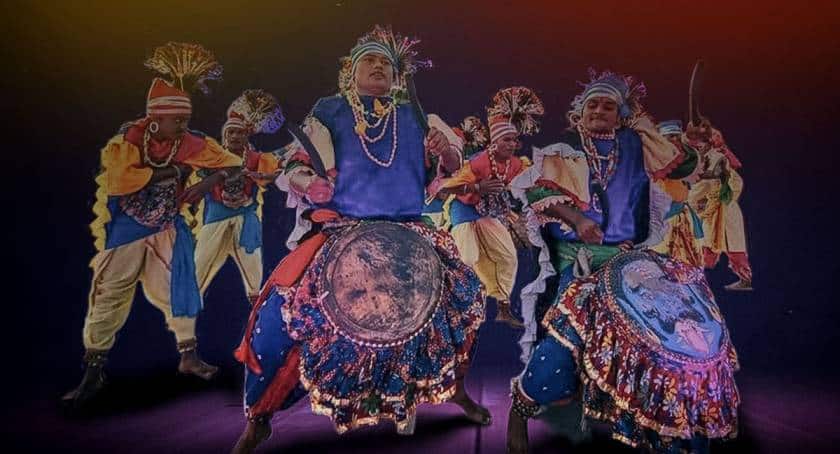Ghumura – Folk Dance of Odisha
India has varied cultural traditions, and folk dances are essential to its rich heritage. One such captivating dance form is Ghumura, a traditional folk dance of Odisha. Deeply rooted in the state’s cultural history, Ghumura is not just a dance but a symbol of Odisha’s valor, spirituality, and artistic expression.
This blog dives into the fascinating realm of Ghumura, examining its history, meaning, music, costumes, and modern applicability.
The Colonial History and Origin of Ghumura
The Ghumura dance has an ancient lineage and likely originated during mythological epics like the Ramayana and Mahabharata. Some historical records suggest that Ghumura was once a warrior dance performed to boost soldiers’ morale before battles. The dance derives its name from the Ghumura, a war drum producing deep, resonating beats.
The Ghumura dance primarily originates from the Kalahandi, Nuapada, Balangir, and Koraput districts of western Odisha, where dancers perform it during festivals and celebrations. Ancient Odia warriors believed the Ghumura dance was a form of military training and motivation before heading into battle. Over time, the martial aspect of the dance gradually evolved into a more cultural and religious performance.
Ancient sculptures and temple carvings in Odisha depict scenes resembling Ghumura dancers, indicating its historical significance. Inscriptions in various temples suggest that Ghumura was also performed in royal courts and religious ceremonies, adding to its rich cultural past.
The Significance of Ghumura in Odisha’s Culture
Ghumura is more than just a folk dance; it is a cultural symbol of Odisha. Over the centuries, it has evolved from a war dance to a devotional and celebratory performance. Dancers often perform it during religious festivals, harvest celebrations, and cultural events.
The dance deeply intertwines with tribal traditions, where people believe it invokes divine blessings. Many temples in Odisha feature depictions of dancers performing Ghumura, signifying its profound religious and artistic importance.
Performers organize Ghumura dances as offerings to the goddess during essential festivals like Durga Puja and Dussehra. The dance is also an integral part of regional fairs and cultural programs, showcasing the artistic excellence of Odisha’s folk traditions.
The Music and Instruments That Make Ghumura Special
At the heart of Ghumura dance lies its powerful music, which creates an electrifying atmosphere. The instruments used in Ghumura performances include:
- Ghumura – A kettle drum, played with sticks, that produces rhythmic beats.
- Nisan – A large percussion instrument that adds depth to the music.
- Dhol – A double-sided drum that enhances the tempo.
- Taal (Cymbals) – Small metallic instruments that keep the beat.
- Flute & Mahuri – Traditional wind instruments that add melody to the performance.
The dancers move in synchronized steps, responding to the beats of these instruments, creating an energetic and visually stunning spectacle. The rhythm of the drums, combined with the graceful yet powerful movements of the dancers, captivates audiences and keeps the tradition alive.
The Beautiful Costumes Worn by Ghumura Dancers
The costumes worn during the Ghumura dance are vibrant, symbolic, and deeply rooted in tribal traditions. The male dancers wear:
- Traditional dhotis in bright colors like red, yellow, or white.
- Ornamental belts and anklets that produce rhythmic sounds.
- A distinctive headgear made from peacock feathers and decorative elements.
- Body ornaments like necklaces and armlets reflect the dance’s warrior heritage.
The overall attire enhances the dancers’ dynamic and bold expressions, visually striking the performance. The elaborate headgear, often adorned with colorful beads and traditional motifs, gives the performers a regal and warrior-like appearance.
The Exciting Dance Moves That Make Ghumura Unique
Male dancers perform Ghumura, forming circular or semi-circular formations. The dance follows a high-energy routine, consisting of:
- Slow and rhythmic movements to establish a dramatic buildup.
- Fast-paced, acrobatic sequences showcasing warrior-like energy.
- Coordinated group formations, symbolizing unity and strength.
- Facial expressions and storytelling gestures narrate mythological tales.
The dancers exhibit exceptional stamina, as the performance requires intense footwork, spins, and jumps. The energetic nature of the dance makes it both a visual and auditory delight for spectators.
How Ghumura is Becoming Famous Around the World
Ghumura has transcended its traditional boundaries and has gained national and international recognition. Performers now showcase it at:
- National cultural festivals represent Odisha’s rich heritage.
- International folk dance events showcasing India’s diverse traditions.
- State-level competitions promoting young talents in folk arts.
The Government of Odisha has taken significant steps to preserve and promote Ghumura by organizing dedicated cultural programs and including it in the state’s folk art curriculum.
Keeping the Tradition of Ghumura Alive for the Future
Ghumura is a dance and a living legacy of Odisha’s warrior spirit, artistic brilliance, and cultural richness. From its origins as a war dance to its present-day role as a vibrant folk tradition, Ghumura continues to captivate audiences with its energy, rhythm, and storytelling. Preserving and celebrating traditional art forms is crucial as we move toward a modern world.


